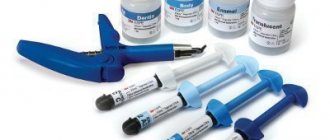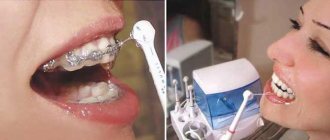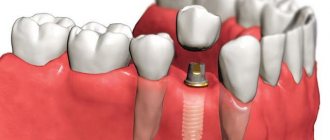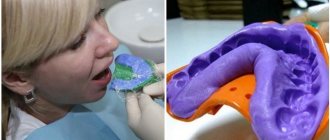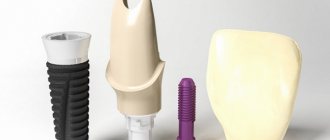18.05.2018
2453
Sign up for a free consultation:
- 1 Features of prosthetics with veneers
- 2 Complications after prosthetics with veneers
- 3 Toothache due to improper fastening of veneers
- 4 Increased sensitivity after veneer application
Among the different prosthetic methods, we can separately highlight the installation of veneers. It is intended to eliminate defects and belongs to the aesthetic field of dentistry. The thinnest plates hide the gaps between the front incisors and allow you to create an ideal smile without wearing braces for a long time. But sometimes a situation arises when the teeth under veneers hurt unbearably, they ache and bother the patient. This feature often occurs when installation technology is violated or other complications occur.
Features of prosthetics with veneers
A similar procedure is used by patients with malocclusions, diastema or darkening of teeth.
This is the only way to create a beautiful smile while preserving the molar crowns without removing them. Veneers are thin plates of durable material. They are placed on pre-treated crowns and secured with a special solution. They are made from ceramics, zirconium dioxide and other hypoallergenic compounds. Sign up for a free consultation:
The procedure for installing such prostheses occurs in several stages:
- A thin layer of natural enamel is removed from the surface of the tooth being restored to create a rough base. Only the front and sides are affected.
- The orthodontist takes an impression and takes the necessary measurements, takes into account all the curvatures and incorrect rotation of the molars, and corrects the length.
- During the production of veneers, exposed areas are covered with hard plastic overlays so that the patient does not experience pain when chewing.
- The dentist secures the dentures with adhesive and closes the gaps between the teeth.
When properly manufactured, miniature plates can last up to 10 years without losing their spectacular appearance. But some patients soon return with the complaint that their teeth hurt unbearably from veneers and the discomfort only increases every day. Normally, any unpleasant sensations should completely disappear 10–14 days after the procedure and not disturb the entire period of wearing.
Sign up for a free consultation:
In what cases can a veneer separated from a tooth be subject to restoration?
Dentists undertake to return a peeled veneer to its original place on the tooth only under one condition - if the veneer has peeled off entirely, there are no chips or cracks on it, and it has not been damaged during storage. It is also not recommended to re-glue a veneer that has already been on the tooth for about 10 years. However, the technology for installing porcelain veneers is relatively new, and there are still very few people in our country who have been wearing veneers for ten years.
But if the veneer is intact and its warranty period has not yet expired, then the porcelain onlay is simply re-fixed on the tooth using a specially designed cementing composition. After this, the tooth can be used in exactly the same way as before until it breaks.
Complications after prosthetics with veneers
It should be noted that when installing plates, patients pursue the goal of obtaining an aesthetic result. Veneers do not affect the ability to chew, but they do give confidence to people who work with the public and want to look perfect. Among the advantages of the procedure is the preservation of molars. Only the thinnest layer of enamel is cut off from them without affecting the pulp or root. After a few years, a person can safely replace the darkened prosthesis with a new one.
Despite all the advantages, installing veneers sometimes results in unpleasant complications:
Sign up for a free consultation:
- The use of low-quality glue leads to the appearance of a microscopic gap between the enamel and the prosthesis. This is fraught with the ingress of food particles and subsequent caries.
- Sometimes the veneer itself is made too large and does not coincide with the base, protruding beyond the edges. It puts pressure on the gum or root molar nearby, causing irritating pain. Microcracks often appear in the mucous membrane, and inflammation occurs.
- Cutting down the enamel too deeply disrupts the dentin layer and causes increased sensitivity of the canals. Teeth hurt severely after veneers when eating hot or cold food, or when going out into the frosty air.
- If the composite is applied directly to the tooth, there is a risk of drying out the layers and the dentin underneath. Gradually, such an incisor becomes covered with microcracks, the edges chip off and microorganisms easily penetrate the roots.
Almost always, the causes of painful teeth with veneers lie in violation of the preparation rules. This is the first stage before installing overlay dentures, on which further comfort and duration of wearing expensive plates depends. In 100% of cases, pain and destruction of enamel will appear if the patient has a complex straight bite, bruxism or chronic gum inflammation. Experienced dentists are reluctant to perform aesthetic prosthetics if the patient has an imbalance of calcium metabolism in the body.
When preparation is not necessary
Teeth grinding will not be necessary if the client is getting direct composite veneers. This is a special type of correction when a special material is applied to the enamel. The process is carried out in one stage. But a composite veneer delivered without treatment is an exceptional case.
Porcelain veneers are made in a laboratory using an artificial impression. The dentist needs to firmly fix the plate, so this is an important procedure for the enamel. Cases when tooth preparation will interfere with natural veneering:
- The surface of the fabric requires compaction.
- There are rough and sharp edges.
- Enamel wear.
- Visual correction of tooth rotation.
When installing veneers from any material (composite, porcelain or ceramic), the enamel must be removed if destruction by caries has begun. The doctor never leaves the anomaly under the veneer. When restoring a missing tooth wall, grinding is not carried out; the dentist gives the enamel the necessary roughness so that the plate is better secured to the surface being corrected.
Modern, expensive lumineers can also be installed without turning or with minimal impact on the enamel:
Toothache due to improper installation of veneers
The quality of the adhesive composition for attaching the plates is of great importance.
It should provide a tight fit, not expand when drinking hot drinks and not cause an allergic reaction. If a dental clinic skimps on materials, situations arise when teeth with veneers hurt after the cement has dried. The cause can only be correctly understood after removing the cover. Sign up for a free consultation:
If no damage, chips or darkening of the enamel is detected, the veneer plates are re-fixed to the teeth with a better composition. If signs of caries appear, the patient will undergo treatment. Photopolymer fillings are applied to the surface, which cover all damaged areas and protect the dental canals from microorganisms. An x-ray helps to ensure that there is no purulent focus and that the roots are in healthy condition.
Sometimes patients turn to the orthodontist too late. Poor quality glue is rejected after a few days, the teeth ache and itch. Symptoms are attributed to the period of adaptation, so they skip the moment of infection of the pulp, drowning out the discomfort with analgesics. In this case, complex treatment is carried out with an attempt to preserve the nerve:
Sign up for a free consultation:
- The veneers are removed, and the crown is cleaned of cement, plaque and food debris trapped in the gap are removed.
- The dentist opens the diseased tooth, carefully removing dying particles and cells of the inflamed pulp.
- The canals are cleared of pus, various antiseptics are used (Chlorhexidine, Miramistin, Fucarcin solution).
- After healing and filling, the doctor can repeat the veneering procedure.
With such treatment, nerve endings are exposed, so cleaning and disinfection is carried out only under local anesthesia. Even with the pulp removed, the tooth is suitable for installation of a veneer, but will last much less.
USEFUL RECOMMENDATIONS
Today, patients in dental clinics place high demands on the aesthetics of their teeth. There is an opinion: a successful person has a radiant smile.
But not every person over the age of 30 decides to completely restore the integrity of the ranks. As a rule, patients turn to doctors with the desire to restore the frontal area, that is, the smile area.
When the lateral units are destroyed or missing, a person begins to chew food with the incisors. But these organs are not intended for chewing processes; they can only be used to bite off.
Not only the enamel, but also the aesthetic plate is unable to withstand such loads. The veneers crack, the enamel begins to wear off intensively, pain and other complications appear. Therefore, before veneering, it is very important to think not only about the beauty, but also about the health of all teeth.
It is also worth remembering that in restoration much depends on the specialist. Aesthetic dentistry requires from the doctor not only experience and professionalism, but also artistic abilities.
It is important to find a good clinic and a dentist who knows his business and knows how to efficiently apply innovative methods for correcting dental defects in practice.
To extend the life of the products, the patient must scrupulously follow the recommended care rules:
- minimize the consumption of foods and drinks with coloring properties;
- stop smoking;
- do not allow the units to be exposed to solid objects;
- use a mouth guard when playing sports;
- brush your teeth twice a day;
- rinse your mouth after every meal;
- use a paste with a low abrasive content;
- avoid using tooth powder;
- maintain hygiene at the proper level with the help of an irrigator;
- visit the dentist once every 3 months;
- carry out professional cleaning in the clinic;
- visit a hygienist.
Increased sensitivity after veneer application
Sometimes discomfort increases 10–14 days after visiting the dentist. This is due to excessive filing of natural enamel. Even with a veneer, the tooth becomes too sensitive and reacts sharply to any change in temperature. The problem can be resolved in two ways:
- Over the course of several days, the patient undergoes intensive fluoridation of the tooth from the back side. A special varnish is applied to the surface, which hardens under a lamp and creates a protective barrier. Additionally, tartar and plaque are removed.
- In severe cases, it is necessary to open the crown and completely remove the nerve bundle responsible for sensitivity. This is an extreme case, significantly reducing the “life expectancy” of a molar to 5–7 years.
Before getting veneers, the patient must become familiar with the specifics of the procedure and understand that it will no longer be possible to return the tooth to its original state. In case of chipping or deformation of the plates, it is necessary to re-manufacture or build up with biocomposite material. Without them, the dentin becomes so exposed that ordinary eating or trying to drink water turns into torture. Therefore, when choosing an orthodontist, you should choose with great care, read patient reviews and not skimp on materials.
Sign up for a free consultation:
Can porcelain veneers come off?
Hello Marina. You addressed your question to an orthodontist, but veneers are orthopedics, so your question was forwarded to me. First reason
The reason why the veneer could come off lies in the condition of the teeth.
That is, the teeth on which problematic veneers are installed are somehow damaged, for example, by caries. The second reason
is that the quality of tooth preparation for veneer, the quality of processing many years ago was different, one might say rougher.
And the third reason
is that all the nuances can be associated with the characteristics of the bite, including changes in the bite, for example, unremoved figure eights, which push the dentition and form crowding in the anterior section and the position of the teeth relative to the lower ones and, accordingly, the lower teeth change These veneers become knocked down due to problems with the patient’s bite. In any case, the veneer cannot be simply removed and re-glued. To remove the veneer, you need to cut it down; in any case, it will deteriorate. And if the veneer chips, then you don’t need to try to glue it at home, since this will not be of any benefit and the chip will happen again very quickly.
If it is necessary to manufacture and install new veneers, it is necessary to look at the specific clinical situation. It often happens that after wearing veneers, the patient needs a crown. That is, it turns out that on the palatal side, now with a veneer the tooth is covered only ¼ to ⅓, and it will be covered from all sides. In fact, a crown differs from a veneer in that a veneer is an overlay on the front surface, and a crown is two linings on the anterior, palatal surface and two lateral ones. In fact, a dental crown is a cap on a tooth. The cap will no longer be able to bounce off the tooth; it can only break if some kind of de-cementing has occurred.
Therefore, two options:
- or redoing the veneers with quality control of the preparation; we won’t be able to add anything if there is more tissue removed than necessary,
- or making a crown for this tooth. But again, you need to look at whether the tooth is alive or pulpless, that is, a veneer was made according to indications or simply as a tribute to fashion at the time, everything is very individual - you need to look.
There are different materials for fixing veneers, in most cases these are so-called dual cements.
Dual cements have double curing, that is, when the components are mixed, the materials harden, it hardens on its own, and plus we illuminate it with a lamp to stabilize the primary hardening. In fact, this cement continues to line up and harden for another day (sometimes longer) and, by the way, the cement is also selected by color. All cements are quite strong, if all the technology is followed and, in general, it is quite difficult to tear off a veneer from this cement; it is also difficult to remove it. I hope I have described in sufficient detail the nuances that lead to the decementing of the veneer and its peeling off from the tooth. The price of veneers varies depending on their quality; such issues are best resolved during a face-to-face consultation at the clinic. Contact us, we will be happy to help you!
Causes of pain
Only an x-ray can help to understand why a patient’s tooth hurts after installing a pin. Sometimes the reason lies in the unprofessional work of a specialist:
- The root canal was damaged by a metal instrument, causing a hole to form in it.
- The doctor placed the pin incorrectly. If the product has been screwed in too deeply, it may rest against the bone, and the tooth will hurt when pressing and chewing, and due to prolonged stress, it may continue to ache even after finishing eating. The intensity of discomfort depends on the complexity of the case.
- Insufficient filling of the canals with filling material.
- Poor quality antiseptic treatment. The bacteria remaining in the root contribute to the development of inflammation, which provokes the appearance of an abscess. If left untreated, an abscess or fistula may develop in the gum.
- The presence of a fragment of a dental instrument in the root.
- Filling material getting beyond the root apex. As a result, there is constant irritation of the soft tissues surrounding the unit, and the patient feels pain when pressed.
We invite you to familiarize yourself with Plasmolifting - a new word in dentistry
Pain in a tooth with a pin can be caused by other reasons:
- carrying out complex treatment;
- allergy to the material of the rod (in parallel, gum hyperemia and stomatitis occur);
- high-mounted seal;
- increased sensitivity by nature (manifests itself when consuming hot/cold and solid foods).
If a patient complains of pain in a long-restored tooth, the causes of discomfort may be:
- insufficient hygiene;
- periodontitis;
- destruction of roots;
- cyst formation;
- presence of microcracks in the unit;
- gum damage.
Can tooth sensitivity increase?
Before installing the veneer, a very thin layer of enamel is removed from the surface of the tooth; this does not lead to disruption of the integrity of the dental tissue. In some cases, this procedure requires local anesthesia.
Creating a beautiful smile using veneers should be entrusted to an experienced professional with a high level of qualifications. The fact is that if it is installed incorrectly, accompanied by aggressive tooth treatment, physiological processes in the dental tissue may be disrupted, and this, in turn, will lead to increased tooth sensitivity.
We suggest you read What to do if white lumps with an unpleasant odor come out of your throat? - So that your throat doesn't hurt


